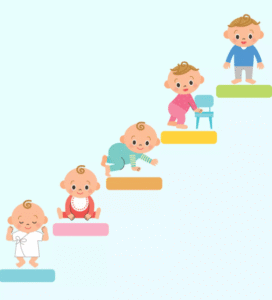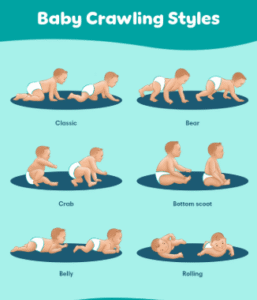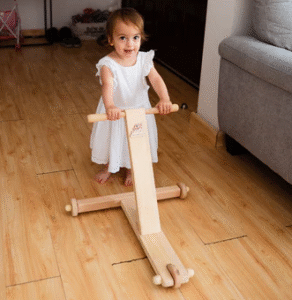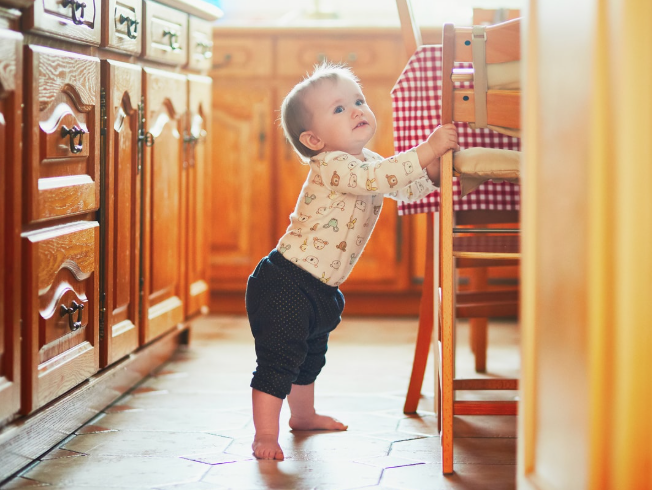What Are the Stages of a Child Learning to Walk? A Parent’s Guide to Every Wobbly Step
Learning to walk is one of the milestones of childhood. Through this article, learn how a child learns to walk and how you can help your baby at each step.
The initial steps of childhood are not merely a physical milestone, but also an emotional moment, more so for parents! When your baby steps on his own for the first time, that experience is always remembered.
But it takes more than a day to learn to walk. It is a step-by-step process beginning from tummy time and progressing to cruising, walking with support, and eventually independent walking.
In this article, we will tell you in detail how a baby learns to walk, what happens at each stage, and how you can make your baby walk confidently and safely. Each child is individual, and his gait is also individual, so let’s begin to comprehend this walking process!
Early Motor Development Milestones (0-6 Months)
The journey of the baby to walk starts as soon as he is born, when he learns gradually to manage his body. The first six months of life are extremely crucial for body development. These are some basic milestones that every parent should know:
1. Importance of Tummy Time – To Make Core Muscles Strong
When you place your baby on his tummy for a while each day (tummy time), it makes his neck, shoulders, and back muscles stronger. These muscles gain the balance and control needed for walking. Begin with brief tummy time sessions 3-5 times per day, which can be increased gradually.
2. Rolling Over and Head Control Development
Rolling over (rolling from stomach to back and vice versa) is a general milestone at the age of 3-6 months. Concurrently, the baby also masters controlling his head. Postural stability, aided by head control, is vital for progressing ahead, standing, and walking.
3. Association of Visual Tracking and Hand-Eye Coordination with Walking
When the baby tracks small objects with his eyes and attempts to catch them with his hands, his hand-eye coordination matures. This coordination is extremely necessary to keep himself balanced while walking. By tracking with his eyes, the baby learns to know the world and engage with it.
4. What to do if the baby is delayed?
If your baby does not enjoy tummy time, head control is poor, or is still not rolling despite 5-6 months, then one needs to be a bit watchful. All babies develop at different rates, but if you always feel like some milestones are getting bypassed, it is best to have a pediatrician or child physiotherapist consulted. Early intervention will be beneficial for future growth.
Sitting Up and Gaining Balance (4–9 Months)
At the age of 4 to 9 months, the baby spends a lot of time developing his strength and body balance. This is an extremely important time for the physical growth of the baby, particularly sitting unsupported. See what all happenings take place at this time:
How sitting unassisted builds trunk strength
When the infant begins sitting independently, his trunk muscles (back and core muscles) slowly begin to become stronger. These muscles assist in posture and establish the foundation for future achievements such as crawling and walking.
You will observe that the baby first falls on the side, but with repetition, he learns how to balance himself.
The function of dynamic balance and coordination
Balance does not entail sitting in place. Dynamic balance entails that the baby maintains body control even though he is shifting it slightly, such as when he leans forward to reach something and then reverts to a straight sitting posture.
This coordination assists the baby in developing awareness of his body and improves muscle control.
Indications your baby is preparing to crawl and pull up
If your baby can sit comfortably and for long hours without support, you can be sure that he is preparing to crawl and pull up. You will also notice that he reaches for toys with his hands, or the hair on one hand begins to move back and forth.
Occasionally, the baby comes up from his belly and begins to pull hair. On the other hand, this is the pre-crawling stage.
Crawling and Discovering (6–10 Months)
1. What are various crawling styles?
Kids learn to crawl in different ways. Here are some popular styles:
Army Crawl: The kid takes the hair on his belly forward, drags it with his hands, but does not walk on his feet.
Hands-and-Knees Crawl: This is the most common crawling style where the kid learns to move on his hands and knees.
Crab Crawl: Here, the child crawls sideways, similar to crabs.
Every style is normal, and every child learns their style.
2. What is wrong if the child misses crawling?
Some kids skip crawling and go straight to standing or walking. Not every child needs to crawl, but:
-Crawling is of great assistance in coordination and balance.
-It makes the hand, leg, and spine muscles strong.
-Crawling also contributes significantly to the development of the brain, as there is left-right coordination of the body involved.
-If the child is skipping crawling but is meeting other milestones, nothing to worry about. But if weakness or movement imbalance is there, then surely visit a doctor.
3. How to encourage crawling and strengthen legs?
You can employ these easy and fun tips to increase your child’s leg strength and crawling ability:
Tummy Time: Get your child to sit on your tummy for a few minutes each day. This helps strengthen the muscles in the neck and shoulders.
Tease by placing a favorite toy at a distance: Place the favorite toy of your child slightly away from him and encourage him to move towards it.
Tunnel Play: Create a crawling route by creating soft pillows or tunnels. He will like it and he will even get some exercise.
Leg Push Games: When the child is lying on his stomach, instruct him to push by providing some resistance to his legs. This will build leg muscle.
Provide additional floor time: The child is to be provided with additional time on the floor to enable him to explore naturally and develop movement
Pulling Up to Stand (8–11 Months)
1. Begin lifting yourself by holding furniture:
Babies at this age learn to lift themselves by holding furniture such as a sofa, bed, or table with their hands. This is a natural process to build their body strength and coordination.
2. Cruising, i.e., walking sideways using furniture:
When the baby learns to pull himself up, he begins to walk sideways (cruising) on the edge of the furniture. This makes their leg muscles and balance stronger.
3. When and how does pulling up occur?
-The majority of babies learn this between 8 and 11 months old.
-Initially, the baby is on his knees, then he uses his hands to hold onto the furniture.
-Gradually, the baby begins to stand on his feet.
-This activity gets better with balance, self-confidence, and leg muscles.
4. Safety precautions for this stage:
-Pad the furniture with sharp edges with corner pads.
–Don’t leave heavy objects like lamps or vases on the table accessible to the baby.
-The furniture must be secure; if the baby grabs hold of it, it must not tip over.
-Pad electrical outlets and hide loose wires.
-Place a rug or carpet on a hardwood floor to keep away from injury in case it falls.

5. Parents should observe the following red flags or warning signs:
-Baby uses one hand or foot on one side only (e.g., always lifts with the right hand).
-Until the age of 11 months, the baby never attempts to pull himself up.
-If the baby is having great difficulty balancing.
-Stiffness or weakness is observed in the limbs on one side.
-If these signs are observed, meet a child physiotherapist or pediatrician once.
Cruising and Supported Steps (9–12 Months)
When the baby starts walking on furniture or other support after crawling, he also begins “cruising”. Cruising is when the baby will move side-to-side using the support of furniture, a sofa or table. Cruising is an essential phase of the baby’s walking development.
What is cruising, and how does it develop foot control?
In cruising, the baby keeps himself balanced using his feet and gains coordination by side movement. When a baby makes small steps while holding furniture, his foot muscles, thighs, and ankles become strong. Through this process, the baby learns correct foot placement and balance, which is essential for independent walking.
How to promote side-stepping and turning?
-Encourage the baby to side-step by putting soft toys or favorite items around the sofa or table.
-Put some toys on both sides so the baby will need to move to the end.
-Encourage the baby’s confidence by providing gentle support when he attempts to turn or change direction.
How to use walkers, push toys, and furniture?
-Utilize push toys like a baby shopping cart or stable walker toys that the baby can push ahead. These aid the baby’s steps without interrupting his walking pattern naturally.
-Use stable and safe furniture in your home for furniture cruising. Steer clear of slippery floors and sharp corners.
-It is advisable to maintain a distance from the old-style walkers because sometimes they may induce walking delays and pose safety concerns.
Leg strength and confidence exercises:
-Let the baby stand on the floor alone and sit down. This makes the leg muscles stronger.
-Sit a little bit away from the baby and invite him to approach you.
-Let your baby have the opportunity to walk barefoot on soft ground so that his balance and grip grow naturally.
-Sit-to-stand games or light bouncing are also useful for leg coordination.
Patience and practice are both needed at this stage. Every baby develops at its own pace, so rather than putting pressure, it is necessary to encourage its confidence.
First Independent Steps (10–14 Months)
When the baby makes his first steps independently, without any support, it is a thrilling and emotional moment for all parents. At this point, the confidence of baby increases, and he becomes physically independent.
1. Signs your baby is ready to walk without support
-The baby begins to stand independently, without any support for a few seconds.
-He attempts to make one or two steps independently, abandoning the support of furniture or any object.
-When the baby falls on the ground, he begins to stand alone without support.
You can see that the baby is getting accustomed to balancing and attempting to walk by keeping his arms to the sides or in front.
2. Normal age range for first steps (and why it differs)
Typically, babies walk for the first time between 10 and 14 months. But with every baby, it may be different. Some babies walk at 9 months, while others might take 15 months. It varies on their muscle power, balance, and confidence. Both early walkers and late walkers are normal.
3. How to manage falls and prevent overreaction
Falling is a normal part of this process. Don’t panic when your baby falls. If you become angry, so will the baby.
-Go to him slowly and encourage him to give it another try.
-Let the baby practice walking on a safe place, such as a carpet or foam mat.
-Comfort him, but don’t discourage his confidence.
4. Encouraging walking with fun, safe challenges
-Stand a little away from the baby and call him – this enhances his motivation.
-Employ soft toys or music push toys so that the baby can learn to walk and enjoy.
-Provide him with an open, safe area where he can walk without any obstacles.
-Smiling and clapping doubles his encouragement.
How to Support Your Child Through Each Stage
Each step of your child’s walking process matters, and your assistance can enhance their growth. Some key tips that you can use to support your child are mentioned below:
Activities and Toys Encouraging Motor Development
Motor-strengthening activities and toys that build your child’s muscles and balance are ideal for your child’s physical growth, like push toys, soft balls, and stacking blocks. These items enhance their coordination and encourage them to walk.
Walking naked is important.
It is highly useful for your child to walk naked because it assists in the strengthening of the muscles and balance of the feet. The child should first be made to walk naked for a while before putting on shoes so that the feet’ natural growth can occur and their grip can strengthen.
Encouragement rather than Pressure: Allow the child to walk as per his convenience
Each child takes time to learn to walk at their speed, so make sure you support them, but not force them. If you pressure or insist that they come along faster, they will get stressed, and that is not good for them. Be patient and appreciate their little milestones.
When to look for expert advice?
If your child is finding it hard to walk by 18 months, or has weakness in muscles, balance issues, or abnormal gait, you should see a doctor or pediatric physiotherapist. Early treatment can detect and correct problems early.
Conclusion:
From wobbly starts to confident steps, your child’s walking journey is a beautiful mix of physical growth and emotional joy. Each stage—from tummy time to cruising to full-on running—brings unique challenges and milestones. Celebrate the small wins, be patient during slow phases, and most importantly, trust the process. If in doubt, reach out to your pediatrician—but remember: every child walks at their own pace!

